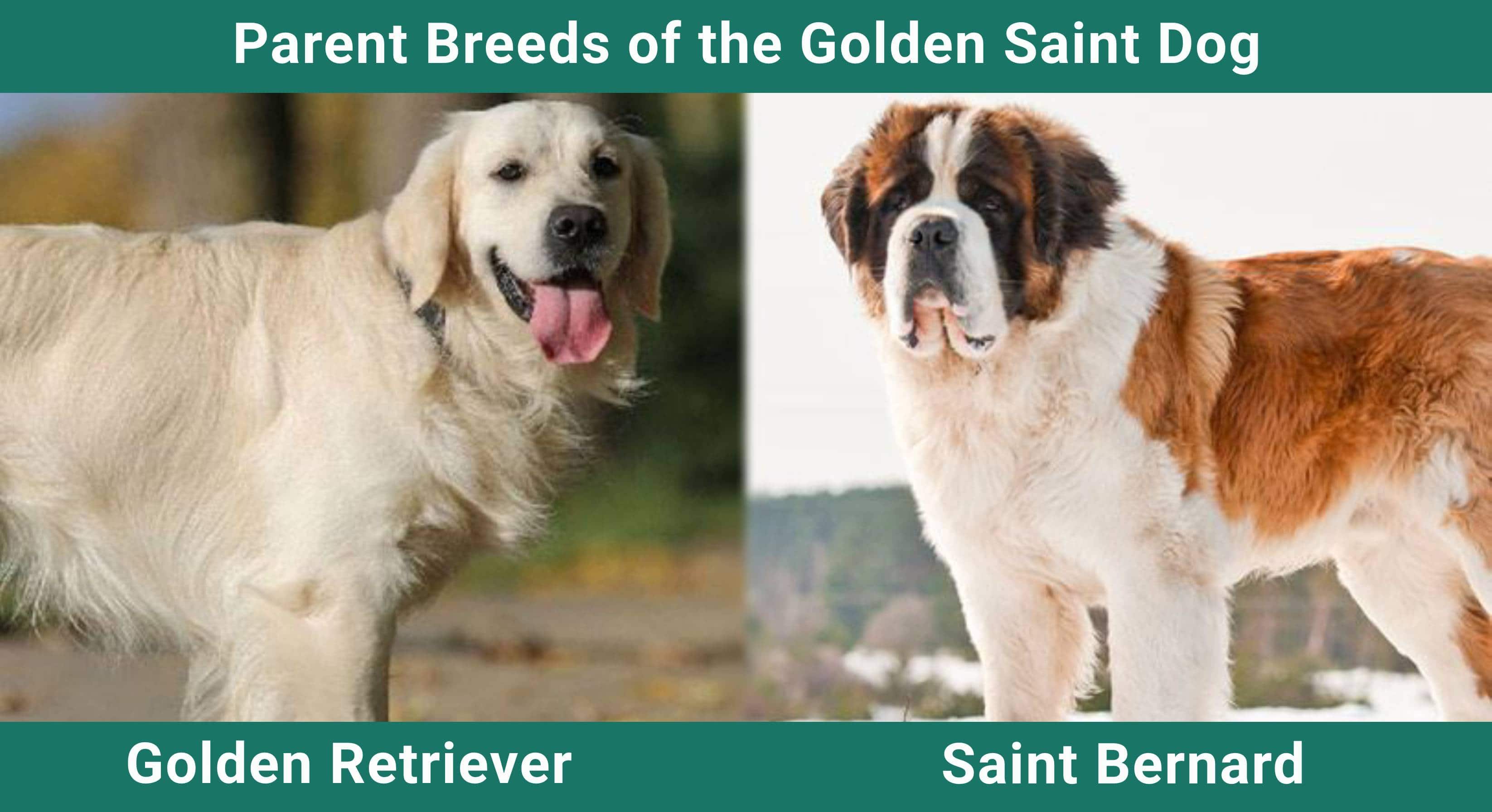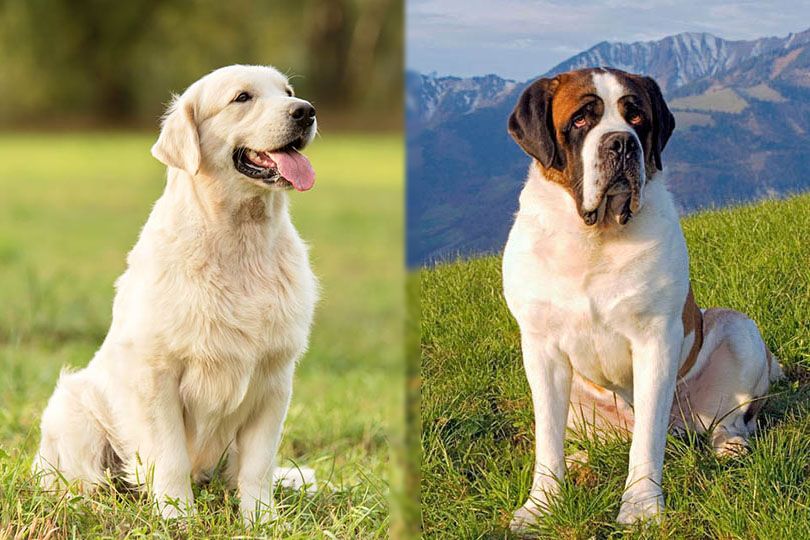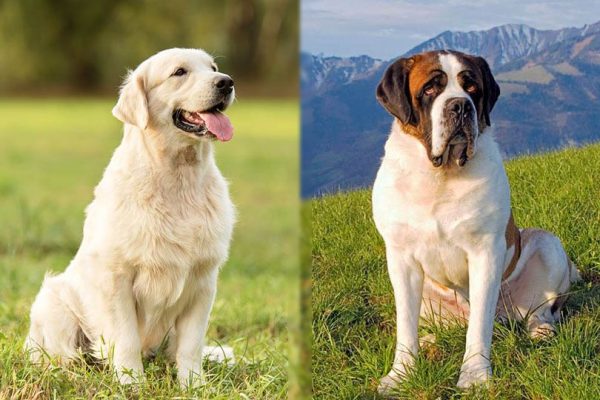Click Below to Skip Ahead
The Golden Saint is a hybrid breed, which means that it results from intentional cross-breeding. In this case, breeders combined the Golden Retriever with the Saint Bernard. The resulting breed is as friendly and mild-mannered as both parents, which usually displays the same physical size as the Saint Bernard parent.
It is considered a good breed for families, including those with younger children because the Saint Bernard especially is aware of its size and inherently avoids causing injury. It really is a gentle giant, albeit a gentle giant that will take up most of the sofa with its 150-pound frame.
Breed Overview
Height:
30 – 36 inches
Weight:
100 – 200 pounds
Lifespan:
9 – 13 years
Colors:
Black, brown, white, gold, tan, yellow
Suitable for:
Novice and experienced owners, including families, with a large couch
Temperament:
Affectionate, loyal, loving, quiet, obedient
The most challenging aspect of owning this cross is its size. It is unlikely to fare well in an apartment setting. The Golden Saint will prefer to have room in which he can comfortably turn and move around.
The size of this breed means that owners usually need to take a leisurely approach to exercise. A 45-minute walk each day should suffice to ensure that your Golden Saint stays healthy and happy. Both parent breeds are working dogs, so they must get enough time outdoors. Thankfully, training this obedient and eager canine should prove easy, especially for experienced hands.
Golden Saint Puppies
The Golden Saint puppy is a hybrid breed, which means that it is not as expensive as a purebred dog. However, it is a big breed. Rearing dogs of this size attracts additional costs and these are passed on to the buyer.
The size of the breed also means that you won’t find too many breeders and may have to travel to find a reputable one. Look for kennels online. Many breeders have a social media presence, so check sites like Facebook. On these sites, you will also be able to join breed groups.
As a hybrid, the cross is not recognized by the American Kennel Club. Ask other owners, or try contacting Retriever and Saint Bernard breeders. If they don’t breed this particular hybrid, they may know another breeder that does.
Ensure you meet the puppy, and its mum before you agree to buy. Ensure that mum looks healthy, both mum and puppy are bright and alert, and that they respond positively to your presence. If in any doubt as to the health of either dog, you should walk away.
The size of this breed can catch some owners by surprise. They grow to a minimum of 100 pounds and can be as heavy as 200 pounds, in some cases.
Adoption is always an option to consider. You won’t usually get access to medical records or the dog’s history, however. The key to ensuring that the dog is right for you is to meet it, walk it, and have it meet the kids and other dogs. If all goes well, you could be taking your own gentle giant home with you.

Temperament & Intelligence of the Golden Saint
The Golden Saint’s parent breeds are known for being friendly and sociable animals, so it is little surprise that the resulting crossbreed is similarly sociable. Most have adopted the Saint Bernard’s gentleness, but accidents can still happen because this is a very large dog breed.
Are These Dogs Good for Families?
The size of the Golden Saint may put families off with very small children, although the breed does know its size and tends to avoid most accidents. Not only are they gentle, but they are also sociable and friendly. They will become a companion to the whole family, eagerly spending time playing with the children. They are usually good with strangers so they will respond well to family and friends visiting.
Does This Breed Get Along With Other Pets?
Again, the size of the breed is the only real challenge when keeping them with other pets. Neither parent breed has too high a prey drive, with the Retriever being used to retrieve dead birds and the Saint Bernand a rescue dog.
The breed usually gets along with other dogs, although they also do well as a sole pet. They should also get along with cats, although you can improve the chances of a successful friendship by introducing the animals when they are both young. Cats may find the size of the hybrid to be intimidating but the pup’s sweet nature could quickly allay any ears.
Things to Know When Owning a Golden Saint:
Friendly and sweet, the Golden Saint could potentially make a great family pet. They are gentle and will fit in with any family members. However, they are large and both parent breeds are prone to some health conditions. Although it may not be as pronounced as it is with the Saint Bernard parent, this cross can be a heavy drooler, and will almost certainly be a heavy shedder. Although it can make a great pet, the breed isn’t ideal for everybody. Read on to see if the Golden Saint is the right choice for your home and your family.
Food & Diet Requirements
This is a giant breed so you should expect a giant appetite. Feed approximately 4 cups of good quality dry kibble, if you feed dry food. You can increase or decrease this a little, depending on whether your dog is active or not, its age, and whether it needs to lose or gain weight.
Be aware that obesity is as dangerous to dogs as it is to people, and the Saint Bernard especially is prone to overeating. Have your dog weighed. Ensure that they are within acceptable guidelines for the breed, and feed according to their desired weight rather than their current weight.
If you feed wet food, you should still make allowances for their current size and activity levels, but feed them according to the manufacturer’s recommendations.
Be especially careful if you feed treats to your dog. A lot of owners fail to take these treats into account when determining how much food they have had.
Exercise
As a giant breed, this hybrid does require exercise. However, that bulky frame also means that they do not need vigorous exercise. A daily walk of about 45 minutes to an hour should be ample and will leave enough in the tank for some playtime outside. In fact, the heft of these dogs means that too strenuous activity could cause injury.
The Saint Bernard is one of the strongest breeds, and while they may not be suited to sprinting or burst activities, they excel at strength-based games and activities like weight-pulling and drafting. They are also good at obedience trials.
Training
For the most part, the Golden Saint is easy to train. Both parent breeds like to please their humans and enjoy praise. They are also both intelligent breeds, and the Golden Retriever, in particular, can be obedient to a fault.
If your dog is more like its Saint Bernard ancestors, it may have a stubborn streak and although your pup will understand commands it may simply choose to ignore them and do something else. This potential stubbornness means that you should socialize and train them from a young age. This is also important because of the size of the dog. The last thing you need is an unruly giant dog that doesn’t understand your commands.
Grooming ✂️
The Golden Saint is a long-haired dog and does require some general grooming, but this shouldn’t be too excessive. Brush the coat once or twice a week to help keep it free from knots and looking good. You can bathe them when needed, but don’t do it too often because this can cause more damage than it cures.
Your dog is likely to drool. You can help keep their chin and neck clean, and potentially prevent the escape of too much slobber, by cleaning around the mouth and jowls with a cloth. Check their ears at the same time, because the breed can be prone to ear infections and other ear problems.
Dogs need our assistance with dental hygiene and nail trimming too. Brush your dog’s teeth at least three times a week and trim their nails approximately every two months. It is best to get into the habit when they are a puppy. They will be more receptive to having your hand in their mouth and around their claws when young, and they will carry this trust through into their adult life. If you still struggle, you may be able to get your vet or a professional groomer to help.
Health and Conditions
The breed is considered to be generally quite healthy and hardy, but it is a giant breed and some health concerns accompany the huge size. It also means that the Golden Saint has a shorter lifespan than smaller dogs. A typical life expectancy for this hybrid is ten years.
Joint Dysplasia – Elbow and hip dysplasia tend to be prevalent in large breeds. Dysplasia means that the ball joint of the elbow or hip is misaligned. It could also be caused by poorly developed ligaments or muscles. Whatever the cause, dysplasia means that the joint does not rest properly in the socket. This disease is congenital so is passed from parent to puppy.
Osteoarthritis – Another common ailment in large breeds is osteoarthritis. This permanent condition occurs when the cartilage around the joints wears down or deteriorates. What starts as a limp may result in lameness and physical pain. Look for signs of discomfort and seek veterinary consultation if spotted.
- Eye abnormalities
- Diabetes
- Von Willebrand’s disease
- Portosystemic shunt
- Hypothyroidism
- Joint dysplasia
- Retinal dysplasia
- Aortic stenosis
Male vs Female
Although the male tends to be a little larger than the female, both genders can be very large. Other than this, there are no major differences between a male and female Golden Saint.
3 Little-Known Facts About the Golden Saint
1. Golden Retrievers Were Bred to Retrieve Game
First bred in Scotland in the 19th century, the Golden Retriever was reared as a working dog. It retrieved shot game for hunters, but their poor performance in the water meant that the original Golden Retriever was crossbred with the Water Spaniel so that it was as confident in the water as it was on land.
The Retriever is still a working dog breed, but it has much broader utility today. As well as retrieving downed birds, the Retriever is used for search and rescue, as a therapy dog, and as a service and therapy dog. They can also be found in yards and on couches across the country, as evidenced by the fact that it is the third most popular breed in the US.
2. Saint Bernards Were Bred as Rescue Dogs
It’s widely accepted that Saint Bernards were originally bred from Molossers, which were large dogs transported to Switzerland by the Romans. They were bred with large dogs from the Bernese mountains, resulting in the Saint Bernard breed.
Several hundred years ago, monks on Saint Bernard Pass bred the dogs and started using them as rescue dogs. They were large and strong dogs with the physical attributes to be able to survive and even thrive in the cold mountainous conditions. They could smell a person buried deep under the snow and naturally detect the start of an avalanche.
It is rare for the Saint Bernard breed to still be used as a working dog, but they make excellent family pets because they are level-headed, surprisingly gentle considering their size, and happy to spend time with their people.
3. Golden Saints Thrive in the Cold
Golden Saints are the result of two rugged breeds. The Saint Bernard comes from the Swiss Alps and was famed for its ability to not only survive in the snow but thrive in such conditions. The size of the dog and the length of its coat means that it struggles with the heat.
The Golden Retriever may not have been bred for quite such extremes but is used to the rough and rugged terrain of the Scottish Highlands, where it gets especially windy and wet. As a result of these two breeds, the Golden Saint prefers cold weather. If you live in a hot climate, you will have to provide measures to ensure that your dog is kept cool.
Conclusion
The Golden Saint is a hybrid that combines the lovable Golden Retriever with the loyal and gentle Saint Bernard. Expect a very large dog, potentially weighing more than 150 pounds. Fortunately, though, this is one breed that lives up to the moniker of a gentle giant.
The giant size means that the breed has a relatively short lifespan. It also means that exercise will usually take the shape of a decent walk, rather than anything too strenuous, and the long coat of both parent breeds means that the resulting crossbreed is best suited to a cold climate rather than anything too hot.
The size of the Golden really is the biggest challenge of owning this dog, but if you have room for one, you can be assured of a loyal and loving addition to the family that is intelligent, eager to please, and easy to train.
- You may also want to read: 15 Saint Bernard Mixes
Featured Image Credit: Left – SasaStock, Shutterstock; Right – rokopix, Shutterstock











